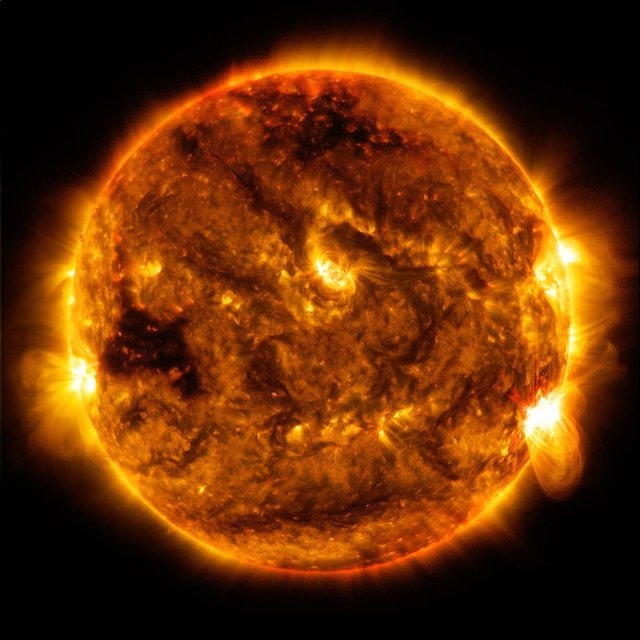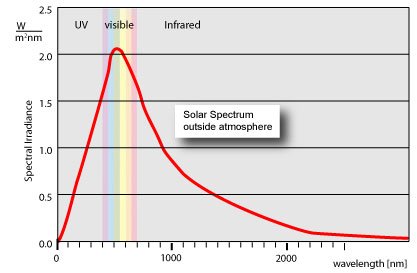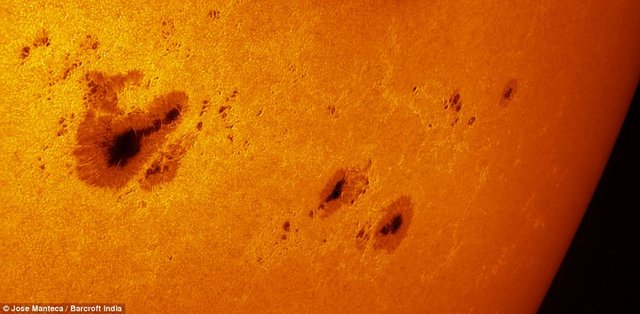(Advanced) How the Sun Works: Part 3
The source of the Sun's energy has been broken down to every individual reaction in the Proton-Proton chain. We've described how that energy wriggles its way out of the Star and is enabled to fly out into the darkness of space.
But much more happens both on the star and along the path of the photons journey. So get ready for more complex, weird, cool, and even somewhat frightening information.
So the photons leave the surface, that's it for them right, each photon just heads out and illuminates the universe. Possibly hitting a planet on the way and going no where else from there. But the path of those photons is not as bland as it may sound. Along the way, light waves collide into one another and blend as result. This is critical to making sense of how the sun looks on all wavelengths.
Light does not leave the star exclusively perpendicular to the surface, it fly's out every way from everywhere. If you think about it, it wouldn't make sense if it didn't. If light only left the star perpendicular to its surface, we'd only see a tiny portion of the surface, as the light from the rest of it would miss our eyes. That's why shadows from the moon look so strange and complex, you have to account for light coming from the center going outwards.
On top of leaving in many directions, blending wavelengths causes a strange effect on the energy in each photon. When you take two wavelengths and mix them, they will turn in to one wavelength that lies somewhere in between the starting two. So when light from the sun mixes, it changes the appearance.
This graph shows the light and its relationship to wavelength. What you may take notice of is that the crest of the graph is clearly in the Blue and Indigo area, then quickly declines once you get into the Ultraviolet.
That seems odd though, the Sun's color is a white with a soft hue of light yellow, why then, is the peak output in the higher energy part of the visible spectrum. It has to do with wavelength mixing.
Indeed on the surface the Sun's main output is a little above the mid-point in the visible range, however when multiple wavelength's mix together, they will average out. As result, all of that infrared light included in there drags the average color of the Sun down, rendering its color output at long range yellow-shifted.
There's another important detail that comes with the Sun's surface. As I said earlier the main method of energy transfer from the upper third of the sun is convection. This flowing of hot gases to the surface carries more than just heat and light. Along for the ride, or rather created during the ride, are tons and tons of charged particles. Magnetic fields of ludicrous size deposited on the surface of the star. These fields have a few observable impacts. One of the most well observed is what you've probably heard of as "Sun-Spots". These spots are characterized as dark regions patching the solar surface. The darkness comes from the cooler temperature, however they are not cooler because they started out that way. These patches are cool because they've been held on the surface for long periods of time, not allowed to sink back into the mantle and allow the hotter gases to take its place. They can be held in place for hours or several days, but the root cause is always the same: magnetic fields gripping the cooler gas in place.
However the sun-spots surprisingly do not decrease the Sun's output. The hotter gas will usually just go around the spots and create brighter regions surrounding them. And the more active the Sun is, the more spots will form, so during the solar maximum, a few year period on the 11-year cycle of Sun activity, the Sun will have more spots, and simultaneously be brighter and more active.
But sometimes these magnetic fields get rather confused, during the solar maximum, the dozens of magnetic fields present in one space can tangle. As anyone whose toyed around with magnets would know, they can strongly resist or attract one another simply sue to alignment. If too many of these fields intertwine in one place, they can trap gargantuan amounts of energy, if that energy builds in between the fields for too long, its possible that the magnetic fields will snap back into place from radiation pressure, releasing huge amounts of energy in one go. Depending on other small specifics, this could either result in a solar flare, a burst of radiation extending from one place, or a Coronal Mass Ejection, which sends a large quantity of magnetically charged solar particles out in some direction.
You've probably heard that these events can be dangerous to us on Earth, not due to the radiation or magnetic storm or anything like that, but rather due to the damages these events will cause to our technology. The truth is these are very real concerns, a powerful coronal mass ejection has the potential to overload our already peak usage grid. Such an event could cause blackouts across an entire hemisphere that would last for months or even years depending on how we prepared for it. This is why research on the Sun is so important, we are still in an infantile stage as far as predicting solar weather. At the moment, we're in the base of a solar minimum, meaning the least amount of activity. However the solar cycle is only 11 years long, the year of 2019 will see an increasing solar output, and it will continue to rise all the way to 2023 and 2024 where it reaches its next peak. Hopefully this increased output phase will allow Solar Physicist to gather more information and make some solid strides in understanding the Sun's magnetic tantrums. Giving us much better chances to see the next big event coming ahead of time and prepare the grid for it. Until then, let's hope things stay calm up there.



Congratulations @astronomyizfun! You have completed the following achievement on the Steem blockchain and have been rewarded with new badge(s) :
Click here to view your Board of Honor
If you no longer want to receive notifications, reply to this comment with the word
STOP